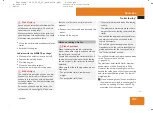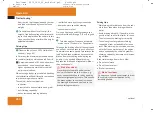
Tyres and wheels
225
lidates the General Operating Permit for the
vehicle.
Notes on selecting, fitting and replacing
tyres
R
Only fit tyres and wheels of the same type
and make.
R
Only fit tyres of the correct size onto the
wheels.
R
After fitting new tyres, run them in at mod-
erate speeds for the first 100 km as they
only reach their full performance after this
distance.
R
Fit new tyres on the front wheels first if
tyres of the same size are required on the
front and rear wheels.
R
Replace the tyres after six years at the lat-
est, regardless of wear. This also applies to
the spare wheel*.
R
Do not drive with tyres which have too little
tread depth as this significantly reduces
the traction on wet roads (aquaplaning).
!
Store tyres that are not being used in a
cool, dry and preferably dark place. Protect
the tyres against oil, grease, petrol and die-
sel.
Notes on regularly inspecting wheels
and tyres
R
Regularly check the wheels and tyres of
your vehicle for damage (e.g. cuts, punctu-
res, tears, bumps on tyres and deforma-
tion, cracks or severe corrosion on wheels),
at least every 14 days, as well as after driv-
ing off-road or on rough roads. Damaged
wheels could cause a loss of tyre pressure.
R
Regularly check the tyre tread depth and
the condition of the tread across the whole
width of the tyre (
Y
page 226). If neces-
sary, turn the front wheels to full lock in
order to inspect the inner side of the tyre
surface.
R
All wheels must have a valve cap to protect
the valve against dirt and moisture.
R
Regularly check the pressure of all your
tyres including the spare tyre*, particularly
prior to long trips, and correct the pressure
as necessary (
Y
page 226).
Notes on driving
R
While driving, pay attention to vibrations,
noises and unusual handling characteris-
tics, e.g. pulling to one side. This may indi-
cate that the wheels or tyres are damaged.
If you suspect that a tyre is defective,
reduce your speed and stop the vehicle as
soon as possible to check the wheels and
tyres for damage. Hidden tyre damage
could also be causing the unusual handling
characteristics. If you find no signs of dam-
age, have the wheels and tyres examined
at a specialist workshop, for example at a
Mercedes-Benz Service Centre.
R
When parking your vehicle, make sure that
the tyres do not get deformed by the kerb
or other obstacles. If it is necessary to drive
over kerbs, speed humps or similar, try to
do so slowly and at an obtuse angle. Oth-
erwise, the tyres, particularly the sidewalls,
could get damaged.
Direction of rotation
Direction of rotation
Tyres with a specified direction of rotation
have additional benefits, e.g. if there is a risk
of aquaplaning. You will only gain these ben-
efits if the correct direction of rotation is
observed.
An arrow on the sidewall of the tyre indicates
its correct direction of rotation.
Operation
* optional
251_AKB; 5; 7, en-GB
wobuchh,
Version: 2.10.6
2008-05-11T14:51:51+02:00 - Seite 225
Z
Dateiname: 6515_1825_02_buchblock.pdf;
preflight
















































